MSI GE40 Review: a Slim Gaming Notebook
by Jarred Walton on July 16, 2013 3:00 AM ESTMSI GE40 General Performance
The GE40 sort of straddles the line between being a gaming notebook and a standard laptop, but we’ll start off with a look at the general performance. Since the model we received has a 128GB SSD, PCMark 7 scores should only be compared with other SSD-equipped laptops to be meaningful. The remaining benchmarks on this page will look more at CPU and GPU performance. We also ran PCMark 8 (1.01—currently available for press use but not quite ready for the public), but we don’t have scores from most of the other notebooks. For the interested, the GE40 scored 4085 in the Home test (and 4108 in Home with the GTX 760M selected for OpenCL 1.1 tasks), 3855 in the Creative suite, 4873 in Work, and 4874 in Storage. As we run PCMark 8 on more notebooks, we’ll eventually include graphs, but for now the full scores are listed in Mobile Bench.
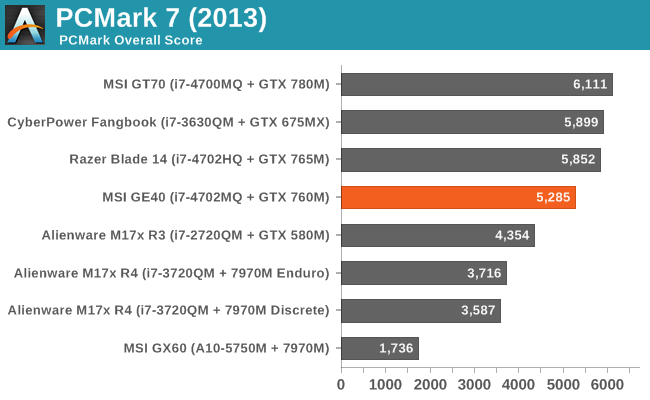

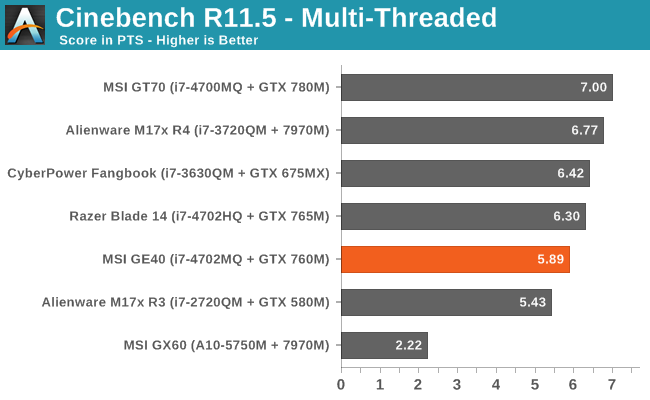
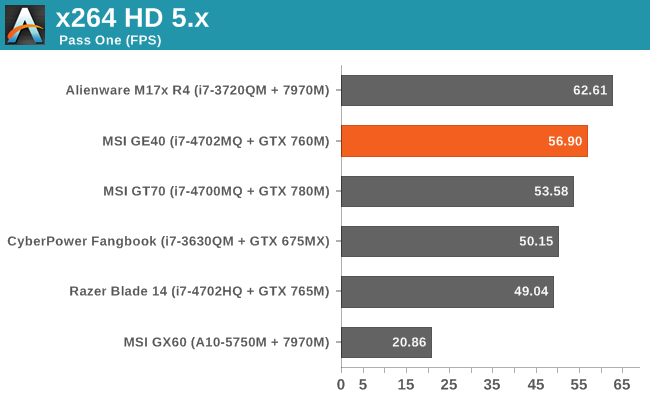
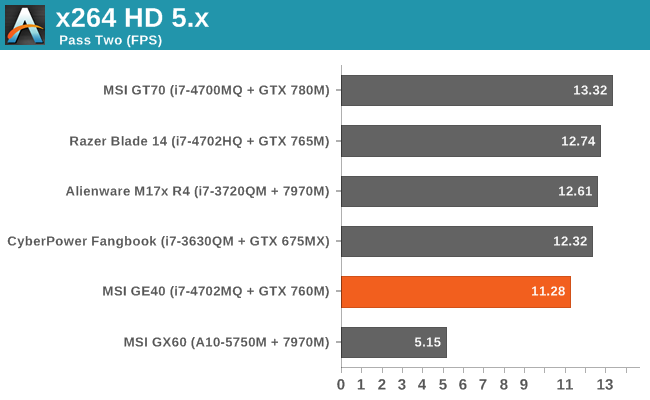
PCMark 7 places the Razer Blade 14 slightly ahead of the GE40, which is interesting as other than the SSD both are running similar hardware—the GPU shouldn’t matter much for PCMark 7. The Cinebench scores are also a bit odd, with the GE40 placing slightly ahead of the Razer Blade 14 in the single-threaded workload but quite a bit slower in the multi-threaded workload. X264 HD 5.0 continues that pattern with the GE40 beating the Razer by over 10% in the first pass, but then it falls behind by over 10% in the second pass. Given the newness of the HM87 chipset and Haswell processors, we are likely seeing minor variance caused by those factors. The GE40 also uses a single SO-DIMM, so potentially memory bandwidth plays a role as well, but outside of iGPU workloads we generally don’t see much scaling of performance with dual-channel memory. Whatever the case, all of the notebooks here (with the possible exception of the GX60) are “fast enough” for all of these tasks, so let’s move on.
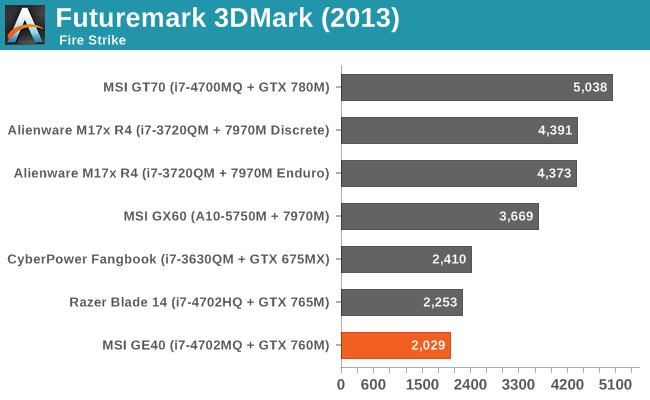
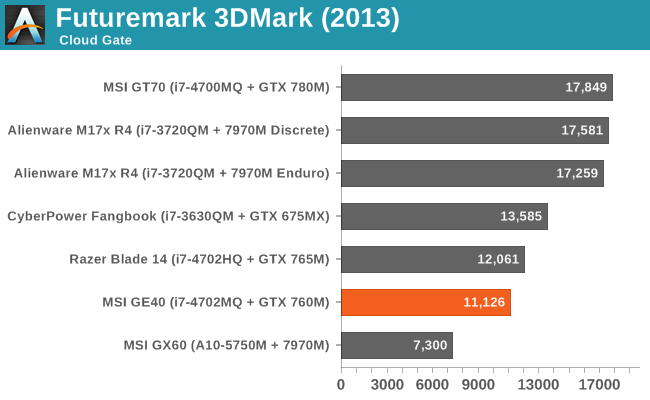
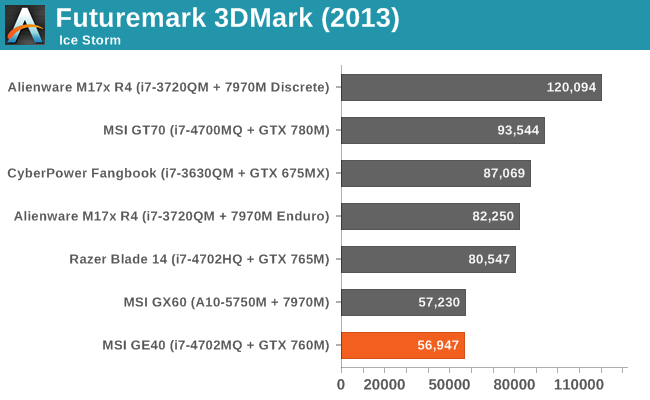
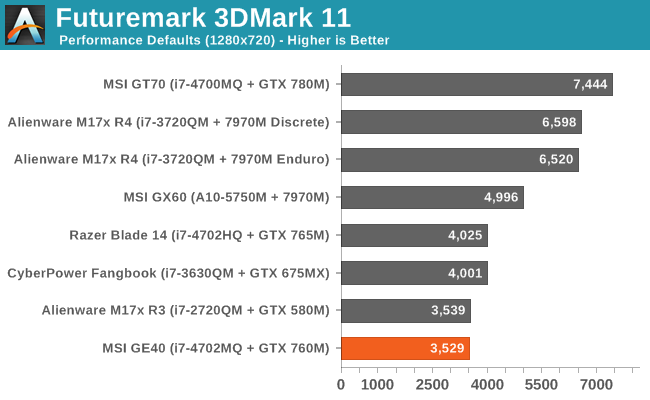
Looking at graphics performance, we start to get a hint of what the gaming benchmarks will tell us. In the mostly GPU-limited Fire Strike test, the GTX 760M places at the bottom of the charts, slightly behind the Razer Blade. Interestingly, while the GE40 is also at the bottom of the Ice Storm chart, it’s now basically tied with the GX60 and the Blade is 40% faster, which is more than the theoretical performance difference so we’re again seeing some discrepancies—possibly the single-channel RAM is to blame, or more likely the GE40 firmware isn’t fully optimized. Finally, in the Cloud Gate benchmark the CPU appears to be more of a factor and the GX60 falls well off the pace set by the Intel-equipped laptops. 3DMark11 on the other hand has yet another set of results, where this time the Sandy Bridge i7-2720QM and GTX 580M tie with the GE40. We don’t have results from the GTX 680M for the various 3DMark tests, though, so let’s see how things look there.










93 Comments
View All Comments
JarredWalton - Tuesday, July 16, 2013 - link
Trinity/Richland simply aren't that powerful. Enduro might be part of the problem, but we can't test the notebook wit Enduro disabled. We're working to get a desktop simulation of the system going, but I don't have the necessary parts so it has to be someone else. I think Ian (over in the UK) may be doing this at some point in the next month or so.silverblue - Wednesday, July 17, 2013 - link
That's very much appreciated, thank you. Granted, no APU is fast in the grand scheme of things, but it'd be nice to pinpoint how much damage Enduro does to performance.It's very warm here at the moment so Ian can take his time. ;)
max1001 - Tuesday, July 16, 2013 - link
I think IPS 900p is what people would prefer. At least offer it as an upgrade option and charge extra $100. It's a win-win for both side.lanestew - Tuesday, July 16, 2013 - link
Yet another disappointing display. Are there any notebooks on the horizon that have a good panel?ijozic - Tuesday, July 16, 2013 - link
It seems that the 14" size is still not that common and all available panels are older mediocre TN-film ones with HD+ resolution. But, as Lenovo Carbon X1 shows, at least it can have a decent brightness output.nicolaim - Tuesday, July 16, 2013 - link
The Lenovo T440s (likely out in August) will have 14" 1600x900 IPS and 1920x1080 IPS LCDs.r3loaded - Tuesday, July 16, 2013 - link
"the LCD is junk" - once again, I lose my appetite for reading a laptop review. Single stream 802.11n is also lame in a $1400 laptop.Jon Tseng - Tuesday, July 16, 2013 - link
While your tests are normally quite comprehensive, one thing I don't understand is why you don't have a battery gaming test? (ditto for the Blade 14 review) After all this is a gaming laptop. A likely use case is to use it for, er, gaming on a long plane or train ride...Suspect the gaming loads are going to be signifiantly different from your Heavy test with full GPU usage. To me whether I'm going to get 1 hour or 2.5 hours of Skyrim has a significant impact on my purchase decision. I suspect others will be likewise.
JarredWalton - Tuesday, July 16, 2013 - link
If you want decent gaming performance while on battery power, I don't know of any specific laptop off hand that will get more than an hour or so. Consider: the CPU has a 37W TDP, and under gaming loads it will at least get pretty close to that number. The GPU meanwhile also has a TDP in the realm of 35-40W. Add in the display, HDD/SSD, motherboard, chipset, etc. and under a gaming load (without throttling the GPU way down to, say, 1/3 the normal performance), you're looking at 80-100W of power use. Result: less than one hour of gaming.I'll go ahead and run a gaming workload tonight -- I'll probably just load Skyrim and sit in Whiterun and let time pass. My guess is at 200 nits (80%) with the GPU set to "Prefer maximum performance" ("adaptive" in the NVIDIA control panel will lower clocks on battery power), we'll be lucky to break an hour. Stay tuned....
JarredWalton - Tuesday, July 16, 2013 - link
Okay, so that didn't take long to see what happens in terms of performance. Plugged in, Skyrim is running at around 67FPS in Whiterun, at the "High" preset with 0xAA and at 1600x900. Unplug it, and even with the GPU set to "Prefer Maximum Performance" it drops down to 30FPS. Looks like NVIDIA is detecting battery power and shooting for 30FPS, and anything more than that is unnecessary. It's not actually a bad way of doing things, but don't expect the same performance on battery as what you get plugged in.Specifically: plugged in, the GTX 760M is running at 718.5MHz/4008MHz GPU/RAM, at 0.893V. The GPU load is 90-97% at these settings. Unplug the laptop and the clocks drop to 627.1/4008MHz, but more importantly the GPU load is at 40-50% and FRAPS is reporting a steady frame rate of 31FPS.